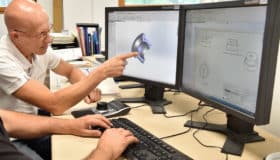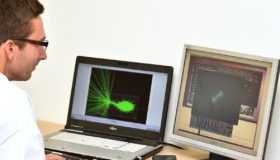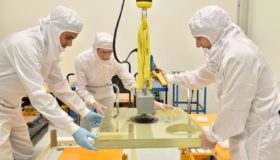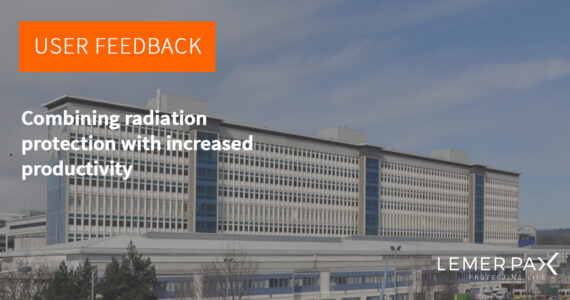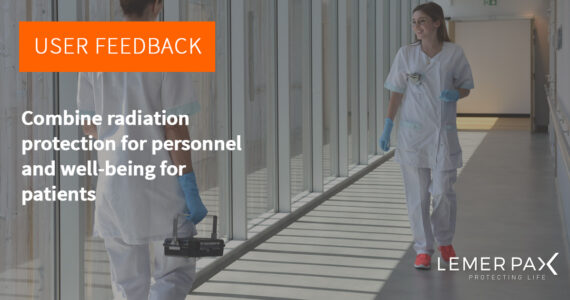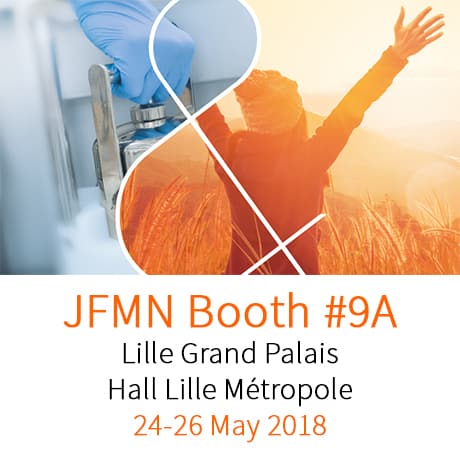
68Ga, progress in theranostics
The JFMN to be held in Lille on 24-26th May, will include several scientific sessions (equipment, oncology, radiopharmacy, etc.) concerning the new perspectives for the use of 68Ga. This is an opportunity for us to provide a brief introduction to this radioelement used in new tracers: its applications, supply and especially the radiation protection equipment it demands.
68Ga opens the door to better patient treatment
Over the last few years, technical and pharmaceutical progress has led to considerable improvements in the treatment of many cancers, both in terms of diagnosis and therapy, and 68Ga has contributed to this.
For neuroendocrinal tumours (NETs), radiopharmaceuticals similar to somatostatin such as DOTATOC and DOTATATE labelled with 68Ga are used in diagnostic examinations. According to Dr Ronan Abgral and Prof. Pierre-Yves Le Roux (CHU Brest), “Functional imaging occupies a key role in diagnosing NETs (neuroendocrinal tumours). Recent advances in radiopharmacy have made it possible to target somatostatin receptors (SSTR) using PET imaging, by combining peptides similar to somatostatin (DOTATOC available in France) with 68Ga, a β+ positron emitting isotope. The 68Ga-DOTATOC tracer has the advantage of having better affinity than Octréoscan® in SPECT/CT for targeting SSTRs. Their use in PET technology offers increased detection sensitivity, in spatial resolution, acquisition time and signal quantification. The relatively short half-life of 68Ga -67.8 minutes) compared to 111In (2.8 days) is also an advantage in terms of dosimetry.
The development of this technique is a real innovation in functional imaging and will eventually lead to the replacement of SPECT/CT exams using 111In-pentetreotide with PET/CT scans using 68Ga-DOTA-peptides for diagnosis, tumour staging and treatment choices for G1 and G2 NETs (low and intermediate grade)” (source: CHU DE BREST)
Moreover, other applications for 68Ga are being developed and studied with very promising results, such as the 68Ga-PSMA PET/CT.
According to numerous studies, combined with a PSMA ligand or antagonist, the 68GaPSMA PET/CT could allow significant progress in the treatment of metastatic prostate cancers. However, this radiopharmaceutical has not yet received market authorisation.
Concretely, the 68Ga-PSMA PET/CT (various variations of the PSMA are undergoing development) would enable a more accurate and reliable diagnosis of prostate cancers and their early recurrence where standard examinations sometimes fail.
“Initial work on 68Ga-PSMA-11 PET/CT has established that this examination can detect the primary tumour in more than 90% of cases… Several retrospective studies have explored the potential impact of 68Ga-PSMA-11 PET/CT on radiotherapy methods in prostate cancer.” It was observed that “in 47% of cases, PET/CT was positive whereas the standard exam was negative”. PET/CT results have changed the treatment of patients in 54% of cases, 46% of which by changing the radiotherapy protocol.” (source: Talbot JN, Balogova S, Huchet V, Nataf V, Kerrou K, Ohnona J, Gauthé M, Jorgov L, GauraSchmidt V,CassouMounat T, Montravers F. Une innovation dans l’imagerie du cancer de la prostate : la tomographie par émission de positons.Innov Ther Oncol 2016 ; 2 : 11-22. doi 10.1684/ito.2016.0023).
Numerous other 68Ga-labelled tracers are in the advanced stages of development as diagnostic tools and for patient selection, and very often associated with their therapy analogues labelled with lutetium-177 in so-called theranostic approaches.
Worldwide Shortage of Ge68/Ga68 Generators
68Ga has the advantage of being available in all nuclear medicine departments purchasing a 68Ge/68Ga generator. 68Ga production and labelling can be done in the department. However, there is currently an issue with generator supply, with delivery times of several months. There are many departments in France awaiting delivery of a generator to start their activity.
“The current production capacity for generators is probably 1 000 to 1 200 generators per year (by 2 main manufacturers), 70% of the production of which goes exclusively to the USA in annual contracts. Eventually, the annual need is estimated at over 40 000 generators for the whole world.
In many countries, an alternative solution is being looked at to overcome this generator production issue, by generating Ga using a cyclotron. Initial tests have shown that the output could reach over 2Ci or 74GBq for a cyclotron using the solid-target production method and over 200mCi or 7400 MBq for a cyclotron using liquid targets similar to those used to produce Fluor-18. A traditional Ge68/Ga68 generator can supply a maximum of 50mCi or 1850MBq when new.” (Source: MEDraysintell)
Specific Radioprotection Equipment
Finally, handling of 68Ga requires specific radioprotection equipment according to its physical properties:
- Mainly 88% positron emissions with maximum energy of 1899 keV
- 12% electronic capture
- 5% gamma emissions with energy of 1.08 MeV
- Half-life of 67.7 mins
As a result, to ensure adequate radiation protection of operators, synthesis and sampling equipment for patient doses need to provide 40 to 60mm of equivalent lead protection (depending on the activity handled). This implies heavy-duty equipment that takes up considerable space and requires departments to reflect on the constraints and floor load limits in radiopharmacy premises, possibly requiring refurbishment.
Moreover, to offer professionals leading-edge equipment suited to their practice and premises, the Lemer Pax and Medisystem R&D teams have developed a range of hot cells specifically for the use of Ga. One of them, the MEDI 9000 RESEARCH has won the trust of many nuclear medicine departments including the CHLS in Lyon, France and the Bergonie institute in Bordeaux, France.
This hot cell enables the production of 68Ga without constraint as it can house all generators on the market, and also accommodate automatic filling of patient dose syringes, with optimal full-body and limb radiation protection.
Lemer Pax and Medisystem are taking the opportunity of the 4th edition of the JFMN to present this hot cell, an innovative answer to the routine use of 68Ga, using virtual reality to test its functionalities.
